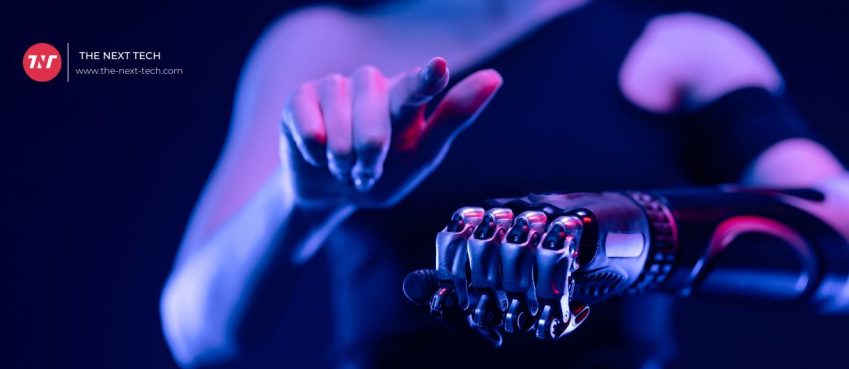
Human augmentation is rapidly gaining popularity.
What if tech-enhanced people take over the world! Hello, Skynet, goodbye, Arnie!
Kidding.
It can be incredibly helpful if you look at it from a realistic perspective. Although human augmentation plays a major role in modern society, it is rarely given the attention it deserves.
It’s still a mystery for many.
Let me assume the role of Scooby Gang and reveal all.
What is Human Augmentation?
Anything that provides cognitive or physical enhancements to the user’s experience is considered human augmentation. It is most commonly used to enhance performance, health, and quality of life.
Let’s now look at human augmentation in greater detail.
It is designed to increase productivity and capability. It can even increase the human body’s health!
Although it may sound futuristic and extreme, human enhancement is already being used.
Important elaboration first:
One of the most important differences between traditional tools & augmentations is the fact that the latter becomes part of you. This includes:
- eyeglasses
- pacemakers
- prosthetics
- wearables
- chip implants
- genetic modifications
The first modern plastic surgery performed after World War I was performed by doctors to reconstruct the faces of soldiers who had been injured. Human augmentation is also possible.
Modern IT advancements have made more wearables and implants possible. Human augmentation is a popular option for millions of people all over the globe.
This tech is sometimes called Human 2.0 because of its functionality.
How does Human Augmentation work? Here’s the deal.
A controller is not necessary. It all connects to your body.
A bionic arm is an example of this. It’s used by people with below-elbow differences in limbs. receives signals. These same muscles are also used to control a biological hand. Imagine flexing your wrist. That’s all the prosthetic can do.
The arm does not need to be surgically attached. All commands are sent through the sensors, which are located at the user’s strongest muscles.
This already feels like the future that sci-fi movies would portray.
However, why limit yourself?
Bioprinting still has its early stages but could make a huge impact on the medical industry. By using 3D printing techniques, you can create organic tissue such as skin and bones.
Human augmentation is not only for medical purposes.
The exoskeleton can be worn outside of the body as a wearable mechanical device. It doesn’t send signals to the muscles but it does provide artificial strength. It can be used to hold an extra 10 kg in each hand.
However, some tools that improve efficiency can also be controlled at a neural level. Elon Musk’s Neuralink hopes to create the first brain-computer interfacing (BCI). Musk’s track record shows that he has made his ideas a reality, even though the technology isn’t yet available.
Human augmentation is a vast field of possibilities.
We might be able to improve our bodies through gene editing or pre-implantation genetic diagnosis.
These experts might be able to edit melanin genes if they unlock their full potential. This could be a major advantage in the fight against skin cancer.
Types Human Augmentation
There are three types of human augmentation.
Augmented Sens
Humans can enhance their senses by interpreting multisensory information.
This type of technology is used most commonly to compensate for impairments. Different technologies can amplify the senses.
One of the best examples is the use of haptic actuators for describing the environment to blind people. This technology can also interpret speech signals for a deaf person.
This tech can not only make up for lost senses but also improve your existing senses.
It has more sensors to observe signals from outside. This allows a person to receive signals beyond what is normal for human capability.
Although our bodies don’t know the signals, technology can “translate” them.
Light sensors, which allow people to see in darkness, are one example. Night vision is a well-known technology, but scientists are constantly innovating new ways to make it more effective.
The ECEye bionic eye could restore vision and even provide new abilities. This could include seeing clearly in darkness and being able to recognize smaller objects from further distances.
Also read: YellowStone Season 5: Part II Myths, Return Date & More! (A Complete Guide)
Augmented Action
This tech is about sensing and mapping specific human actionsin remote, local, or virtual environments.
There are many subclasses for Augmented Action. These are the most popular:
- Speech input
- Gaze-based controls
- Motor augmentation
- Amplified force
Prosthetic limbs are the best example.
Augmenting human activity can be a step ahead of the natural motor and sensory limits.
Exoskeletons can be programmed to perform manual tasks, but they still need human intelligence. These exoskeletons can be used to aid people who don’t necessarily require Artificial Intelligence.
Also read: Top 7 Best ECommerce Tools for Online Business
Augmented Cognitive
This type of human augmentation deals in things such as:
- cognitive psychology
- neuroscience
- engineering
- Computer science
- Human-computer interaction (HCI).
Modern technology can detect human cognitive state. This process uses analytical tools that interpret the commands received from the user.
This could eventually improve working memory and attention spans.
Use Cases
Human augmentation is a common practice in many industries.
Let’s take a look at some of the most popular uses for it:
Medicine
Medicine is one of the most popular uses for human augmentation.
The Naked Prosthetics company can already reproduce amputated fingers with extreme precision.
eSight makes wearables that bring images closer to the eyes of legally blind people. The device can be attached to your head, and will improve your functional sight.
Organovo, a San Diego-based company, is currently developing a line human tissues for medical research and drug discovery.
Some human augmentation tools can even be used to simplify the lives of medical professionals.
Japan’s Cyberdyne created a HAL suit to make it easier for patients and relieve the burden on medical staff.
Also read: What Is Gaming In Metaverse? 7 Best Metaverse Games To Play In 2024
Manufacturing
When it comes to manufacturing, automation is a hot topic. Machines are able to do the same things that people are doing now, and they are getting more.
Human augmentation, however, can change the way that manufacturers work.
Some devices can help workers make fewer mistakes, produce better quality and increase their long-term well-being.
They are usually only used or attached by an individual during work hours.
Exoskeleton wearable devices were mentioned earlier. Ford equips its employees with EksoVest from EksoBionics to help them manage more weight.
Perceptual Robotics Laboratory in Italy has created a similar tool. The Body Extension allows the user to hold up to 50kg in each arm.
Skylightby Upskill – Aviation engineers can make key parts of the engine, such as B-nuts. To keep your aircraft in operation, it is important that all these parts are properly tightened.
Also read: [Fixed!] Janitor AI Not Working (2024 Guide)
Other
As people love to say, the sky is the limit. There are many other uses for human augmentation.
Wearable devices are available for miners to improve safety and productivity. A hat developed by the US-based company Guardianhat that can detect people and communicate with their supervisors directly has been created.
Technology exists that can increase soldiers’ awareness while operating heavy machinery.
What’s next for Human Augmentation?
Gartner says that will see higher levels of cognitive and physical human augmentation over the next ten years.
This technology is changing rapidly. More investors and businesses are joining the game.
MarketsandMarkets predicts that the market for human augmentation will reach $206.9 billion in 2024.
This will lead to a new consumerization effect, where more people will use it, especially for work.
However, there are some areas that businesses need to focus on before adopting this technology. These include security and data privacy, as well as the possible impact on mental and physical health.
Also read: [10 New] Best OnionPlay Alternatives To Stream TV Shows And Movies
Wrap up
What is human augmentation, then?
It is a way to integrate tech so that people can live better lives.
There’s no need to be Sarah Connor. It will take technology a while longer to bring us down. It’s here for now.
If we can help a blind man see, then I’m excited to see what the future holds. I’m open to any and all improvements that can be made to people’s well being.
Top 10 News
-
01
10 Exciting iPhone 16 Features You Can Try Right Now
Tuesday November 19, 2024
-
02
10 Best Anatomy Apps For Physiologist Beginners
Tuesday November 12, 2024
-
03
Top 10 Websites And Apps Like Thumbtack
Tuesday November 5, 2024
-
04
Top 10 Sites Like Omegle That Offer Random Video Chat
Monday October 21, 2024
-
05
Entrepreneurial Ideas To Make 5K In A Month (10 Realistic Wa...
Monday October 7, 2024
-
06
[10 Best] Cash Advance Apps Like Moneylion And Dave (No Cred...
Friday September 20, 2024
-
07
Top 10 Richest Person In The World
Tuesday August 27, 2024
-
08
Top 10 Unicorn Startups In The World (2024-25)
Monday August 26, 2024
-
09
Top 10 IT Companies In The World By Market Cap
Thursday August 22, 2024
-
10
[10 New] Best OnionPlay Alternatives To Stream TV Shows And ...
Tuesday June 11, 2024







